The SCC Tester Market is estimated to be valued at USD 2.3 billion in 2025 and is projected to reach USD 4.0 billion by 2035, registering a compound annual growth rate (CAGR) of 5.5% over the forecast period.
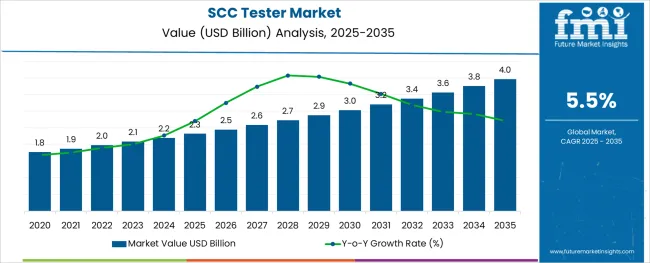
The SCC tester market is growing steadily, driven by the increasing demand for quality control in concrete construction projects. Industry experts have emphasized the importance of ensuring concrete workability and flow characteristics to achieve durable and high-performance structures. The rise in infrastructure development, particularly in bridges and large civil engineering projects, has led to more rigorous testing requirements.
Technological improvements in testing equipment have made it easier for construction teams to assess concrete properties quickly and accurately on-site. Increasing regulations and standards in the construction industry have also pushed for widespread adoption of reliable testing methods.
Future growth is expected to be supported by the expansion of infrastructure spending globally and the emphasis on sustainable, long-lasting concrete structures. Segmental momentum is anticipated to be led by the Workability test type, True Slump as the primary end result, and bridge construction as the key application area.
The market is segmented by Test, End Result, Application, and End User and region. By Test, the market is divided into Workability, Water/Cement Ratio, and Consistency. In terms of End Result, the market is classified into True Slump, Zero Slump, Shear Slump, and Collapsed Slump. Based on Application, the market is segmented into Bridges, Piping, Dams, and Roads.
By End User, the market is divided into Construction Industry, Civil Engineering, and Government Contracts. Regionally, the market is classified into North America, Latin America, Western Europe, Eastern Europe, Balkan & Baltic Countries, Russia & Belarus, Central Asia, East Asia, South Asia & Pacific, and the Middle East & Africa.
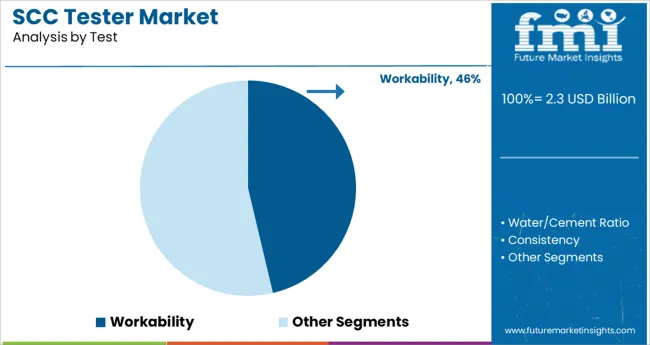
The Workability test segment is expected to account for 46.3% of the SCC tester market revenue in 2025, holding its position as the leading test type. This segment’s growth is attributed to the critical role workability plays in ensuring concrete can be properly mixed, transported, placed, and compacted without segregation or excessive water content.
Construction professionals prioritize workability testing to maintain consistency and quality in concrete batches. The segment has benefited from advances in test methods that allow quick and repeatable measurements on-site.
Additionally, growing infrastructure projects demand stringent quality checks, increasing the reliance on workability tests to avoid structural defects. As industry standards continue to evolve toward higher quality and safety, the Workability test segment is expected to maintain its leadership.
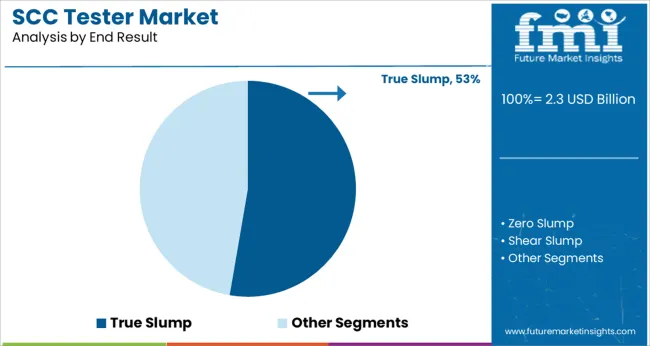
The True Slump segment is projected to contribute 52.7% of the SCC tester market revenue in 2025, establishing itself as the most important test result parameter. The true slump test provides a direct measurement of concrete consistency and fluidity, helping engineers predict the ease of concrete placement.
It has been widely adopted due to its simplicity and ability to reflect real-world handling characteristics of self-compacting concrete. The increasing use of self-compacting concrete in complex structures and congested formwork has amplified the need for reliable true slump testing.
Regulatory compliance and quality assurance programs often require true slump values to ensure proper mix design and performance. With growing emphasis on construction efficiency and defect prevention, the True Slump segment is poised to remain critical in the SCC tester market.
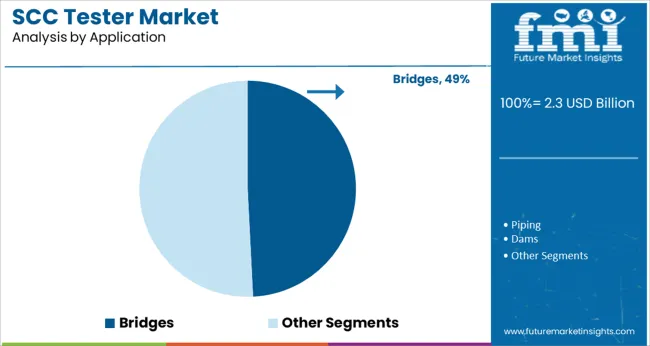
The Bridges application segment is projected to hold 49.2% of the SCC tester market revenue in 2025, maintaining its position as the dominant application area. Bridge construction demands high-strength durable concrete with excellent flow characteristics to fill complex formworks and avoid voids.
The structural importance of bridges has led to strict testing protocols and quality assurance measures during concrete placement. Infrastructure investments and renovation of aging bridges in many regions have contributed to increased use of SCC testing in this sector.
The segment has been supported by growing government funding and the drive toward longer-lasting infrastructure that can withstand harsh environmental conditions. As bridge projects continue to grow in scale and complexity, the Bridges segment is expected to sustain its leading market share.
The prominent feature that drives sales of SCC testers is that they offer more benefits at a lower cost. SCC testers offer the easiest test to determine strength and workability of concrete. The cost of SCC testers is also quite low. Further, test report provided by an SCC tester is often immediate.
Manufacturers are making use of advanced technologies to introduce SCC testers that offer multiple advanced features. For instance, a low-cost steel sheet SCC tester that is corrosion resistant, lightweight and portable, was manufactured and introduced by Multiserw-Morek.
Another factor that is substantially accentuating the growth in the SCC tester market is the low maintenance cost. SCC testers provide immediate results and do not require extensive maintenance.
Several elements can impact the result of the concrete testing. Mixing methods, admixtures, properties of materials, and dosage can impact the test calculations, producing incorrect results. Invalid results given out by SCC testers can adversely impact the construction of any building, thereby restraining growth in the SCC tester market.
Neglecting even minimal maintenance such as cleaning the tester before and after use further affects the working of SCC testers. These factors might limit sales of SCC testers over the forecast period.
Asia Pacific is anticipated to register significant growth in the SCC tester market. This is primarily due to the involvement of various government agencies and the policies implemented by them to further develop the construction and infrastructure sector. The resultant growth of the construction sector is expected to boost sales of SCC testers in Asia Pacific.
Expansion in the construction sector across countries such as India, China and South Korea will continue augmenting the growth in the market over the forecast period.
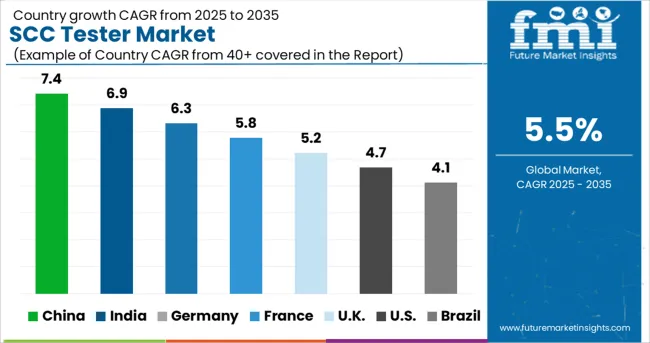
Europe is expected to account for a dominant share in the global SCC testers market over the forecast period. Government funding with respect to automation and construction will propel demand for SCC testers in countries such as Germany, the UK, and France. Such developments are expected to bode well for the growth in the market in the forthcoming years.
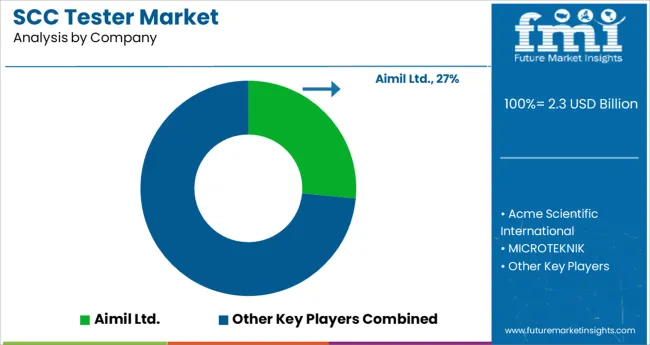
The global SCC tester market is moderately competitive. Key players present in SCC tester market are Aimil Ltd., Acme scientific International, MICROTEKNIK, Sun LabTek Equipments Pvt. Ltd., NL Scientific Instruments Sdn Bhd, HUMBOLDT Mfg. Co., MATEST, among others.
Leading players are investing in research and development activities to manufacture new products and expand their current product portfolios to retain consumers.
| Report Attribute | Details |
|---|---|
| Growth Rate | 5% - 6% |
| Base Year for Estimation | 2024 |
| Historical Data | 2020 to 2024 |
| Forecast Period | 2025 to 2035 |
| Quantitative Units | Revenue in million, and CAGR from 2025 to 2035 |
| Report Coverage | Revenue Forecast, Volume Forecast, Company Ranking, Competitive Landscape, Growth Factors, Trends and Pricing Analysis |
| Segments Covered | Test, End Result, Application, End User, Region |
| Countries Covered | North America (USA., Canada), Latin America (Mexico, Brazil, Argentina, Peru, Chile, Rest of LATAM), Europe (Germany, Italy, UK, Spain, France, Nordic countries, BENELUX, Eastern Europe, Rest of Europe), CIS & Russia, Japan, Asia Pacific Excluding Japan (Greater China, India, South Korea, ASEAN Countries, Rest of APEJ), Middle East and Africa (GCC Countries, Turkey, Iran, Israel, S. Africa, Rest of MEA) |
| Key Companies Profiled | Aimil Ltd.; Acme scientific International ; MICROTEKNIK; Sun LabTek Equipments Pvt. Ltd. ; NL Scientific Instruments Sdn Bhd ; HUMBOLDT Mfg. Co.; MATEST |
| Customization | Available Upon Request |
The global scc tester market is estimated to be valued at USD 2.3 billion in 2025.
It is projected to reach USD 4.0 billion by 2035.
The market is expected to grow at a 5.5% CAGR between 2025 and 2035.
The key product types are workability, water/cement ratio and consistency.
true slump segment is expected to dominate with a 52.7% industry share in 2025.






Our Research Products

The "Full Research Suite" delivers actionable market intel, deep dives on markets or technologies, so clients act faster, cut risk, and unlock growth.

The Leaderboard benchmarks and ranks top vendors, classifying them as Established Leaders, Leading Challengers, or Disruptors & Challengers.

Locates where complements amplify value and substitutes erode it, forecasting net impact by horizon

We deliver granular, decision-grade intel: market sizing, 5-year forecasts, pricing, adoption, usage, revenue, and operational KPIs—plus competitor tracking, regulation, and value chains—across 60 countries broadly.

Spot the shifts before they hit your P&L. We track inflection points, adoption curves, pricing moves, and ecosystem plays to show where demand is heading, why it is changing, and what to do next across high-growth markets and disruptive tech

Real-time reads of user behavior. We track shifting priorities, perceptions of today’s and next-gen services, and provider experience, then pace how fast tech moves from trial to adoption, blending buyer, consumer, and channel inputs with social signals (#WhySwitch, #UX).

Partner with our analyst team to build a custom report designed around your business priorities. From analysing market trends to assessing competitors or crafting bespoke datasets, we tailor insights to your needs.
Supplier Intelligence
Discovery & Profiling
Capacity & Footprint
Performance & Risk
Compliance & Governance
Commercial Readiness
Who Supplies Whom
Scorecards & Shortlists
Playbooks & Docs
Category Intelligence
Definition & Scope
Demand & Use Cases
Cost Drivers
Market Structure
Supply Chain Map
Trade & Policy
Operating Norms
Deliverables
Buyer Intelligence
Account Basics
Spend & Scope
Procurement Model
Vendor Requirements
Terms & Policies
Entry Strategy
Pain Points & Triggers
Outputs
Pricing Analysis
Benchmarks
Trends
Should-Cost
Indexation
Landed Cost
Commercial Terms
Deliverables
Brand Analysis
Positioning & Value Prop
Share & Presence
Customer Evidence
Go-to-Market
Digital & Reputation
Compliance & Trust
KPIs & Gaps
Outputs
Full Research Suite comprises of:
Market outlook & trends analysis
Interviews & case studies
Strategic recommendations
Vendor profiles & capabilities analysis
5-year forecasts
8 regions and 60+ country-level data splits
Market segment data splits
12 months of continuous data updates
DELIVERED AS:
PDF EXCEL ONLINE
5G Tester Market Growth – Trends & Forecast 2019-2027
RF Tester Market Growth – Trends & Forecast 2019-2027
LAN tester Market Size and Share Forecast Outlook 2025 to 2035
LED Tester Market
DSL Tester Market Growth – Trends & Forecast 2019-2027
Drug Tester Market Size and Share Forecast Outlook 2025 to 2035
Gold Tester Market Size and Share Forecast Outlook 2025 to 2035
Tube Tester Market Size and Share Forecast Outlook 2025 to 2035
CCTV Tester Market Size and Share Forecast Outlook 2025 to 2035
RFID Tester Market Size and Share Forecast Outlook 2025 to 2035
Pump Testers Market Size and Share Forecast Outlook 2025 to 2035
Food Tester Market Size and Share Forecast Outlook 2025 to 2035
Paper Tester Market Size and Share Forecast Outlook 2025 to 2035
Scuff Tester Market Size and Share Forecast Outlook 2025 to 2035
Paint Tester Market Size and Share Forecast Outlook 2025 to 2035
Hipot Tester Market Analysis – Share, Size, and Forecast 2025 to 2035
Mining Tester Market Size and Share Forecast Outlook 2025 to 2035
Torque Testers Market
Allergy Tester Market Size and Share Forecast Outlook 2025 to 2035
Density Tester Market Size and Share Forecast Outlook 2025 to 2035

Thank you!
You will receive an email from our Business Development Manager. Please be sure to check your SPAM/JUNK folder too.
Chat With
MaRIA